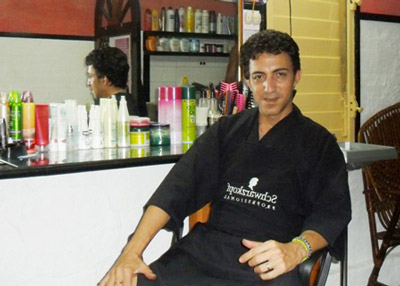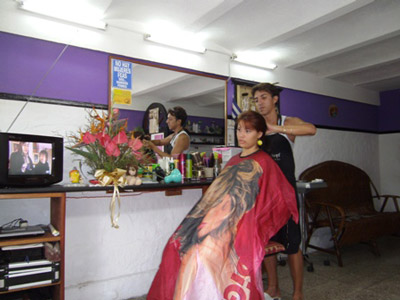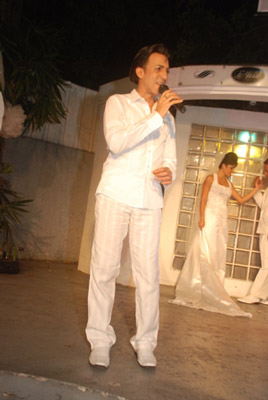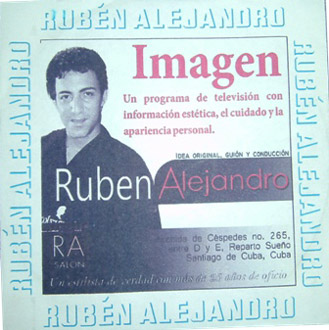An Interview with a Cuban Stylist
Dariela Aquique

HAVANA TIMES — A stylist is a professional who acts as a beauty consultant, providing clients with advice on the basis of the fashions and trends of the moment. Ruben Alejandro Collantes, whom we interview today, is such a professional.
HT: Why did you choose to become a stylist?
R.A: I think the decision came about as a result of many things I’ve done. I studied architecture. This afforded me a number of tools that proved useful later on: a grasp of three-dimensional space, a sense of color harmony, a knowledge of forms.
Afterwards, I worked at Local Industry Design Center. It was an incredible experience. Back in the days of the Special Period, these centers, faced with many material shortages, came up with brilliant design solutions. Ironically, I think it was the one point in Cuban history in which an authentically Cuban fashion emerged. Linen, which is a highly porous fabric, began to be used and the thick garments manufactured in socialist bloc countries, which is what people wore in the 70s and 80s and which were completely unsuited to our climate, began to disappear.
Silk-screened garments also came into style. I don’t even know how people managed to paint their clothing, but it was all very original. We began seeing shoes made out of rudimentary leathers, accessories and costume jewelry made out of natural fibers, seeds, seashells and so on and so forth. We also saw the rebirth of traditional crafts and hand crafts, macramé, tapestries, and leather products. I think this contributed a lot to Cuban fashion, without copying foreign trends.
Later, I completed a number of fashion courses. Afterwards, I worked with a fashion group and then at the Maison Santiago. I’ve worked a in number of salons in Jamaica, Trinidad and Tobago and the Dominican Republic. In short, I accumulated experience and interests and I think that’s the reason I became a stylist.
HT: Some years ago, the work of stylists wasn’t looked upon well in Cuba. It was considered a trade or profession for homosexuals or effeminate men. Do you believe this impression has at all changed?

R.A: It’s changed a bit, but not because of the campaigns organized by Cuba’s National Sexual Education Center (CENESEX), or because there’s greater tolerance towards the gay community or anything of the sort. I think things have changed because people have had to look for different ways of making a living through private initiative. Despite this, I still disagree with some forms of discrimination that still remain, at least in Santiago de Cuba, like this whole business of talking about barbers and hairdressers, that the barber cuts men’s hair and the hairdresser works with women. Unfortunately, because of this, hairdressers don’t learn to cut men’s hairs and barbers don’t know how to style women’s hair.
In these new courses that are being offered now, where people are being trained in different trades, I try to emphasize the importance of not making these strict distinctions.
I imagine that this habit of pigeonholing different disciplines will disappear over time and we won’t have to deal with the tired cliché that men go to barber shops, not beauty salons, or that women shouldn’t go to a barber’s, but to a salon or the hairdresser’s.
The need to earn money will make people be more open and offer a higher quality service. This will help get rid of these divisions.
On the other hand, we’ve always had many stylists and hairdressers that are heterosexual through and through and who are absolutely brilliant in what they do. For instance, the founder of the Hairdressing Museum in Cuba and of the Artecorte project, Cuba’s national hairdressing award laureate, is heterosexual.
HT: There are many ways to become a stylist in the world, including higher level professional training, degree programs in fashion design, image consultancy, the design of fashion accessories and modeling. There are fashion design and even hairdressing, makeup and fashion photography courses. In a scale of 1 to 10, where would you place Cuban professionals in this field today?

R.A: Definitely a 1, because we don’t have any such high level programs, and because the courses we do have are inadequate, from the way the students are selected to the syllabuses, which are really old and out of date. We’re still teaching courses with Soviet textbooks. Access to the Internet is also a problem. On top of this, practically nothing makes it out here to the interior, not the seminars they hold in Havana every time a new product is put on the market, nor the new fashion trends, etc. If you don’t go out hunting for this information and don’t get it yourself, you’re always behind, you never make any progress.
HT: More and more people, both women and men, seem to be interested in their personal appearance. In the case of men, we’re seeing a growing metrosexual trend. Has the male clientele at beauty salons or stylist’s been growing?
R.A: According to statistics, men are consuming 60 % of the world’s cosmetic products. The metrosexual phenomenon has brought about this increase. It was in the 90s that Beckman introduced these concepts surrounding the care of male appearance, which have nothing to do with an individual’s sexual preferences, but are related to the care of physical appearance by men, practices which had been traditionally female.
And, yes, the male clientele at these places has grown around the world. Cuba is no exception.
HT: You host a TV show called Imagen, sponsored by the Santiago de Cuba Telecentro. Could you tell us about this program?
R.A: It was an idea I kind of came up with during the time I was narrating fashion shows at the Maison Santiago. I didn’t like the fact the shows were silent and I had the idea of spicing things up, providing people with information which wasn’t evident to them, the type of fabric used and what it represented, the types of design lines used, etc.
The show has been on the air for four years. It’s in its fourth season, there are ten episodes in each season. I write the script and host the show. The aim is to educate the public, inform them on fashion matters.
HT: Should people consult stylists to use of piercings, get tattoos, put on ear extensions or any other type of physical modifications (including plastic surgeries)?
R.A: I think so, yes. Any physical modification to our bodies done out of pleasure is a very serious decision that shouldn’t be made rashly, because they’re things we’ll have our entire lives and our aesthetic taste changes over time. Life also tends to place you in places or situations where those things aren’t well received. Sometimes, certain faces or bodies don’t look well with bodily modifications, marks, piercings and other things.
At the risk of being called backward, I think people shouldn’t be allowed to do these things until they’re of age, because the way you think or how you want to look when you’re 15 or 16 is almost never the way you want to look when you’re 30 or 40.
That’s why I think people should seek advice from a beauty consultant for these procedures, someone who can explain to them that they are irreversible and that they entail physical and even psychological risks.

HT: As we’ve said, the fashion world is huge. The stylist’s work includes everything from selecting the right elements for an editorial piece in a magazine, through publicity campaigns, television shows and music videos to presentations during concerts and any public appearance by a model or celebrity. To what extent do you think Cuba’s media avails itself of the work of the stylist?
R.A: The medium where the work of the stylist is most evident right now is the music video. It tends to be anonymous work, however, because the singer, producer, editor, photographer, director and practically everyone else may get credit, but the beauty consultant or stylist does not.
I don’t know why we still don’t have any programs where the clothes a model, famous artist or any public figure wears during a public appearance is commented, as you were saying right now. It would be good if we could talk about their clothing, hair style, make up, the accessories they wear, what they put on, what they avoid, what suits a given context, etc.
The work of the stylist is of the essence for public events, so it is important to acknowledge this work. I feel it’s not taken advantage of enough. A lot of the time, we see celebrities in the media who have dressed themselves, styled their own hair and made themselves up, and sometimes the result is embarrassing.
HT: Considering that there are more and more people interested in maintaining a good physical appearance, that the price of cosmetics are rather high and that the State has ceased subsidizing practically all beauty services (now offered by the self-employed), do you think the work of the stylist could become a profitable business in Cuba’s future?
R.A: For the longest time, these services were totally subsidized by the State. There were always people offering private services, of course, but, today, most of the people offering such services are self-employed.
I have my own salon, I run my own business, manage the resources I need. I always try to keep abreast of new trends and techniques.
This is not the case with most people out there. Things have opened up dramatically. For instance, they’re now offering hairdressing and makeup courses, handing out licenses, renting out locales to many people in the field or interested in the trade, but many people have no talent for this, and we’re talking about an artistic trade. It requires sensibility, a certain degree of education, if you wish. Being a hairdresser or makeup artist, or being knowledgeable about these things, isn’t enough.
I think many of these businesses will go under in the short term, or will became very basic locales for cutting and washing hair, shaving people or doing manicures. Prices will have to be moderate. On the other hand, we’ll have other salons with quality services that could become very profitable businesses.
